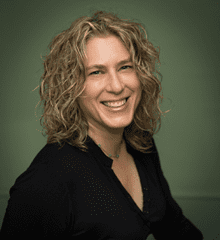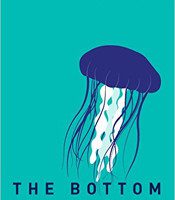When I first began reading Betsy Andrews’ book-length poem, The Bottom, I was reminded of an incident that occurred nearly two years ago now. In October of 2012, an article appeared on Slate.com regarding a large, startlingly-blue eye that had washed up on a Florida beach. Its size and opulence could not immediately be placed with any one undersea creature; and its dismemberment, washed up, created a stir. I remember when the article first appeared, there was a buzz of conversation: a guessing game of potential creatures and legends, not to mention the calendrical proximity to Halloween. But though these exchanges were entertaining, if not thought-provoking at times, I couldn’t help but think of isolation.
You see, when I think of the ocean, I visualize that deep blue, waves crashing, a tan beach—yes—but I also see a lot of open space: room for the sunlight to cut through, for the shadow of ships overhead, and the occasional creature—a shock of color and contrast. An eye, perhaps. I couldn’t tell you what led me to this visualization, or why it’s the first image to come to mind when I think of great expanses of water, but it is. I can imagine, too, the reefs and the wreckage and the pollution, etc., but I’m plagued with this concept of isolation. It’s hardly the conceptual journey you would expect after the mind-numbing push of Finding Nemo and “Under the Sea,” which embrace the fun, color and activity of undersea life… but I think what I see delves deeper, somehow; I end up in a place where I can see the beauty and the power, in all that richness, and perhaps a hint of what’s become of it.
For me, this is largely where The Bottom comes in. Ecopoetic and political (as I feel there can be a division between these two schools), it first emphasizes the problem and specific connection to nature, or the ocean, and, second, points us toward a solution—a wish, even. This poem took me back to the works of Robert Hass, Gary Snyder, Lorine Niedecker and, particularly, Eva Saulitis, each of whom have thrived in developing that connection between nature and their personal selves, their physicality and their lifestyles, through their works. Through the engine of this poem, the speaker challenges us to look at the role we’ve taken in the cycle of the ocean, presents to us a personal wish and tests our perceptions of what the ocean is, all of which may construe our understanding of the human condition.
Throughout this entire poem, there are suggestions of our influence and involvement in the natural world, from the dumping of a Tide bottle to references to Alice in Wonderland to absolute demolition for the construction of yet another Burger King. These references are feisty and poignantly-inserted into these otherwise-snappy and quickly-moving sections. One after the next, we move from images of a single jellyfish riding a Tide bottle to a mermaid killed on collision to a small whale caught in a Brooklyn waterway. These images are striking, painful and brutally honest; Andrews does not spare us with sentimentality but, rather, of a more scientific mind, presents hard image as fact. In each of these sections, isolated on their own page, given their own white space, these creatures and their tragedies return us again and again to the isolation performed by nature, by pollution and human involvement.
This is where the wish—the call to action—comes in. Being one of her strong suits, Andrews employs the art of repetition as a calling from the main speaker to an other, as portrayed through “you and I” and “my love” throughout the course of the poem. Being placed within such a scientific, factual and political poem, this move, at first, startles. However, as the first connection between the speaker and this other is achieved on the very first page, we, as readers, are given an opportunity to emotionally connect not only out of logic, but empathy. Here is how the first section (the first page) of the poem ends:
My wish is: We are on the shore, we are looking out at the water.
You are lying beside me, curled.
The sun is coming up. I am turning you over
I am going to see your face
The sun is coming up, I am turning you over
I am going to be able to see your face
Not only does this passage achieve a connection between these two personas, but it also provides an emotional longing that stands throughout the poem, and it performs Andrews’ subtlety. The ending punctuation disappears when the certainty, when the present-tense, is no longer in the speaker’s possession; so, too, the variance of the third-to-last and final lines, which may represent the difference between potential outcomes and the hope for potential outcomes. While these may appear to be small achievements, they represent an opening-up: a scope of what is come in this larger project of calling for action, calling for connection (between human and human, and human and creature), and calling for an end to isolation or disparity. By pointing out the difference between what could be and wanting what could be, Andrews calls into question the very center of political poetry: the difference between an action that will cause change and an action that only could.
Finally, we reach this point (which really began with the inclusion of the D.H. Lawrence epigraph) of interpreting what the ocean really is—which becomes the question, why we should care about it. I save this particular aspect of my review for now, because I think this question ties everything together. Lawrence describes the ocean to a baby tortoise as a “huge vast inanimate,” which had my mind reeling for a large portion of the poem. Stemming from my own personal visualizations of the ocean, I have a difficult time seeing it as an inanimate (though, yes, I understand it is the creatures that live within the ocean that are animate, rather than the whole body itself); because of all that occurs within it, because of it, and because of what happens to it (pollution, etc.), I have difficulty seeing this body as an inanimate one, as opposed to large, feeling and living. And I think this idea is one that the speaker similarly contests, given the natural protectiveness that occurs throughout this poem—toward individual creatures and the larger ecosystem alike. Perhaps, too, this relates back to the speaker’s “you and I” sentiment that occurs throughout; not only could the other be a person (connecting, again, to our human condition) but also the ocean itself (developing a connection between the human and nature). Yes, this takes us back to the ecopoetic edge of The Bottom, relating man to nature, but (again) there’s also this empathetic connection that we’re able to develop, by perceiving the “you” as human, as ocean, as living.
 What’s so beautiful about all three of these themes is not only how Andrews achieves to tie them together into one poem, but her techniques in doing so—and how those techniques greatly mirror that of the ocean itself. Andrews has a beyond-admirable understanding repetition, rhythm and humor that, when thrown against such a large issue as harming our oceans, is striking and impressive. Haunting, even. The repetition of images (say, the mermaids and the shipwrecks), the repetition of the relationship (the “you and I” and “my love”), the continued vastness and isolation—each of these create an echo, a thread, an arch, that keeps us moving along, connected, over the course of this book-length poem. Add in, too, Andrews’ use of rhythm and rhyme (both direct and slant), as well as revision of phrases (such as the third-to-last and final lines on the first page) that keep us coming and going, that throw us into a rhythm that could easily be connected to the ebb and flow of the ocean itself, its breathing, the waves. Finally, while this poem is extremely unrelenting, extremely brutal and challenging, the humor contained not only sharpens that brutality but can almost give us split-seconds of reprieve, allowing us to judge ourselves and laugh at ourselves when we realize the absurdity of “Have It Your Way” when compared to the complexity, beauty and importance of an ocean. The combination, here, of taking us back to previously-stated lines and images, to revising a line, to propelling us forward through rhythm, to complicating our understanding of the situation through a combination of harshness and perhaps even harsher humor, it leaves us off-balance, ebbing, which very well may be the whole point: we should be thrown off by the depth of our involvement in what’s happening to our oceans, our planet. And maybe we should be even more thrown off by what it’ll take to correct it.
What’s so beautiful about all three of these themes is not only how Andrews achieves to tie them together into one poem, but her techniques in doing so—and how those techniques greatly mirror that of the ocean itself. Andrews has a beyond-admirable understanding repetition, rhythm and humor that, when thrown against such a large issue as harming our oceans, is striking and impressive. Haunting, even. The repetition of images (say, the mermaids and the shipwrecks), the repetition of the relationship (the “you and I” and “my love”), the continued vastness and isolation—each of these create an echo, a thread, an arch, that keeps us moving along, connected, over the course of this book-length poem. Add in, too, Andrews’ use of rhythm and rhyme (both direct and slant), as well as revision of phrases (such as the third-to-last and final lines on the first page) that keep us coming and going, that throw us into a rhythm that could easily be connected to the ebb and flow of the ocean itself, its breathing, the waves. Finally, while this poem is extremely unrelenting, extremely brutal and challenging, the humor contained not only sharpens that brutality but can almost give us split-seconds of reprieve, allowing us to judge ourselves and laugh at ourselves when we realize the absurdity of “Have It Your Way” when compared to the complexity, beauty and importance of an ocean. The combination, here, of taking us back to previously-stated lines and images, to revising a line, to propelling us forward through rhythm, to complicating our understanding of the situation through a combination of harshness and perhaps even harsher humor, it leaves us off-balance, ebbing, which very well may be the whole point: we should be thrown off by the depth of our involvement in what’s happening to our oceans, our planet. And maybe we should be even more thrown off by what it’ll take to correct it.
What Betsy Andrews has created here is stunning. Her gathering and mastery of information, her understanding of this wide and complex creature, is compelling, enriching and (dare I say it) enviable. She reminds us of the ocean’s power but also its weakness, its dependence on our actions. She teaches us about its dichotomy. While this world is, in fact, beautiful and full of wonder and reasons for celebration, it contains darkness, too—some of which stems from the truths of survival and others from our blunders as human beings. Like all of nature, our respect should be a combination of our love for its beauty and understanding of its harshness. Unrelenting, powerful and musical, Andrews reminds us of this duality of this mysterious space, the light and dark of its reach. Like a wide, startlingly blue eye, we may lose sight of its origins, its connectivity… but Andrews largely earns that connection back, through her creation of a speaker and their connection to an other (whether human or ocean), and through her mastery of language, which represents those many nuances, movements, emotions, and breaths of these wide bodies of water of which we so easily take advantage.




